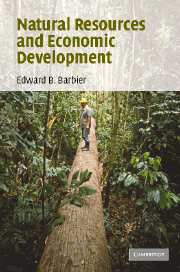Book contents
- Frontmatter
- Contents
- List of figures
- List of tables
- Acknowledgments
- Introduction
- 1 Natural resources and developing countries: an overview
- 2 Natural resource-based economic development in history
- 3 Does natural resource dependence hinder economic development?
- 4 Frontier expansion and economic development
- 5 Explaining land use change in developing countries
- 6 The economics of land conversion
- 7 Does water availability constrain economic development?
- 8 Rural poverty and resource degradation
- 9 Can frontier-based development be successful?
- 10 Policies for sustainable resource-based development in poor economies
- References
- Index
8 - Rural poverty and resource degradation
Published online by Cambridge University Press: 06 July 2010
- Frontmatter
- Contents
- List of figures
- List of tables
- Acknowledgments
- Introduction
- 1 Natural resources and developing countries: an overview
- 2 Natural resource-based economic development in history
- 3 Does natural resource dependence hinder economic development?
- 4 Frontier expansion and economic development
- 5 Explaining land use change in developing countries
- 6 The economics of land conversion
- 7 Does water availability constrain economic development?
- 8 Rural poverty and resource degradation
- 9 Can frontier-based development be successful?
- 10 Policies for sustainable resource-based development in poor economies
- References
- Index
Summary
“People in poor countries are for the most part agrarian and pastoral folk … Poor countries are for the most part biomass-based subsistence economies, in that their rural folk eke out a living from products obtained directly from plants and animals.”
(Dasgupta 1993, pp. 269 and 273)Part One of this book provided a broad overview of the role of natural resources in economic development. Part Two focused on the economic driving forces behind two key resource problems in many poor economies: widespread land conversion and the increasing demand for freshwater.
The following chapter, which begins Part Three, centers on a third important aspect of natural resources and economic development in poor countries, namely that much of the population in low and middle-income economies is concentrated in rural areas and remains dependent on agricultural and other renewable resources for their livelihoods, as emphasized by the above quote from Partha Dasgupta. This has two important implications for an economic approach to improved resource management for sustainable development in poor countries. First, we need to understand better the linkages between rural poverty and resource degradation in order to understand why the environment-poverty “trap” is so entrenched in many poor rural areas. Second, as we shall see in the final two chapters of this book, Chapters 9 and 10, understanding how this rural poverty-resource degradation arises in developing countries is critical to designing appropriate policies and reforms to improve overall resource-based development in developing economies.
- Type
- Chapter
- Information
- Natural Resources and Economic Development , pp. 286 - 320Publisher: Cambridge University PressPrint publication year: 2005
- 2
- Cited by



